Robinhood Markets Bundle
Who Really Controls Robinhood Markets?
Ever wondered who truly calls the shots at Robinhood Markets? The company, a fintech disruptor, has revolutionized how we invest, but its ownership structure is a complex web. Understanding the dynamics of Robinhood Markets SWOT Analysis and its shareholders is key to grasping its future trajectory. This exploration will unravel the layers of Robinhood's ownership, from its founders to the major institutional players shaping its destiny.
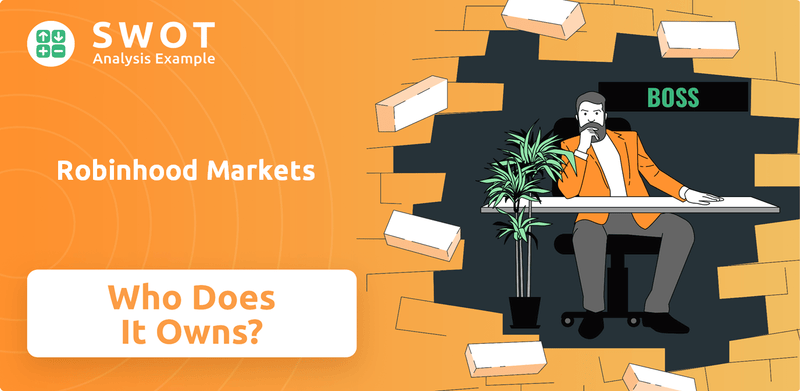
From its inception, understanding the Robinhood ownership has been crucial, especially given its rapid rise and impact on the financial landscape. As a publicly traded company, Robinhood Markets faces scrutiny from a diverse group of Robinhood investors, including institutional investors and individual shareholders. This deep dive into Who owns Robinhood will provide valuable insights into the Robinhood company's strategic direction and its ability to navigate the ever-changing market dynamics, including the influence of its board of directors and key executives.
Who Founded Robinhood Markets?
The story of Robinhood Markets began in 2013 with Vladimir Tenev and Baiju Bhatt, the co-founders. Their vision was to revolutionize the financial industry by making investing more accessible and affordable for everyone. Their experience in building high-frequency trading platforms gave them unique insights into the inefficiencies of traditional brokerage models.
At its inception, the initial ownership of Robinhood Markets was primarily held by its founders. While the precise percentage splits aren't publicly available from the early private stages, it's common for co-founders to have roughly equal shares, often subject to vesting over time. This structure ensured their long-term commitment to the company's success.
Early funding was crucial for Robinhood Markets. The company secured investments from angel investors and venture capital firms. These early investments typically involved preferred stock, which influenced the early control dynamics of the company.
Early investors played a significant role in shaping the Robinhood Markets. These investors provided crucial capital in seed and Series A rounds, which influenced the early control dynamics. Vesting schedules were in place for the founders to ensure their long-term commitment to the company.
- Founders: Vladimir Tenev and Baiju Bhatt, held significant equity stakes.
- Early Investors: Google Ventures, Andreessen Horowitz, and Index Ventures.
- Investment Rounds: Seed and Series A rounds provided the initial financial backing.
- Stock Types: Preferred stock was issued, often with specific rights.
The founders' focus on democratizing finance was central to the company's early development. This likely influenced the ownership structure, aiming for a model that supported rapid growth and broad accessibility. As of early 2024, the company's ownership structure has evolved, with a mix of institutional investors, public shareholders, and the founders still holding significant stakes. The Robinhood stock (HOOD) is publicly traded, with its ownership now distributed among various shareholders.
Robinhood Markets SWOT Analysis
- Complete SWOT Breakdown
- Fully Customizable
- Editable in Excel & Word
- Professional Formatting
- Investor-Ready Format
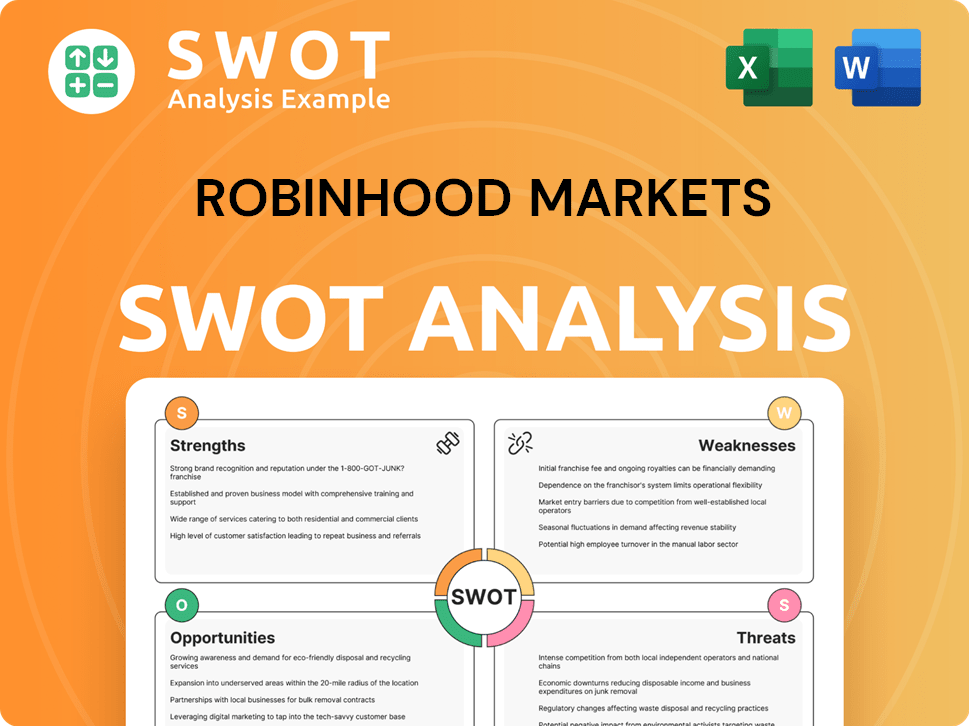
How Has Robinhood Markets’s Ownership Changed Over Time?
The ownership structure of Robinhood Markets has significantly evolved, especially following its initial public offering (IPO) on July 29, 2021. The IPO, trading under the ticker HOOD, priced shares at $38, valuing the company around $32 billion at the time. This transition shifted ownership from its founders and venture capitalists to a broader base, including institutional and retail investors. Post-IPO, regulatory filings and annual reports have detailed shifts in major shareholding.
As of early 2025, major institutional investors hold significant portions of Robinhood's stock. Vanguard Group Inc. and BlackRock Inc. are among the largest institutional holders, with their index funds and ETFs holding substantial passive stakes. Other notable institutional investors include hedge funds and asset management firms. Founders Vladimir Tenev and Baiju Bhatt still retain significant ownership, often through Class B shares, which offer higher voting power, allowing them to maintain considerable control despite holding a smaller percentage of total equity. This dual-class share structure is a common mechanism for founders to retain control post-IPO. These ownership changes have directly impacted Robinhood's strategy, balancing growth with profitability and regulatory scrutiny.
| Key Event | Date | Impact on Ownership |
|---|---|---|
| IPO | July 29, 2021 | Diversified ownership base; public shareholders added. |
| Subsequent Funding Rounds | Ongoing | Dilution of founders' and early investors' stakes. |
| Institutional Investment | Ongoing | Increased holdings by firms like Vanguard and BlackRock. |
The shift from a private entity to a publicly traded company has changed the focus of the Robinhood company. The need to balance growth with profitability and navigate regulatory requirements has become more critical. Understanding the Robinhood ownership structure is essential for anyone interested in the Robinhood stock and the company's future direction. As of March 2024, the company's market capitalization was approximately $14 billion, reflecting market adjustments since the IPO.
The ownership of Robinhood Markets has evolved significantly since its IPO. Key stakeholders include founders, institutional investors, and public shareholders. Knowing who owns Robinhood is crucial for understanding the company's strategic direction.
- Founders retain control through dual-class shares.
- Institutional investors hold significant stakes.
- Public shareholders comprise a broad base of investors.
- Ownership structure impacts strategic decisions.
Robinhood Markets PESTLE Analysis
- Covers All 6 PESTLE Categories
- No Research Needed – Save Hours of Work
- Built by Experts, Trusted by Consultants
- Instant Download, Ready to Use
- 100% Editable, Fully Customizable
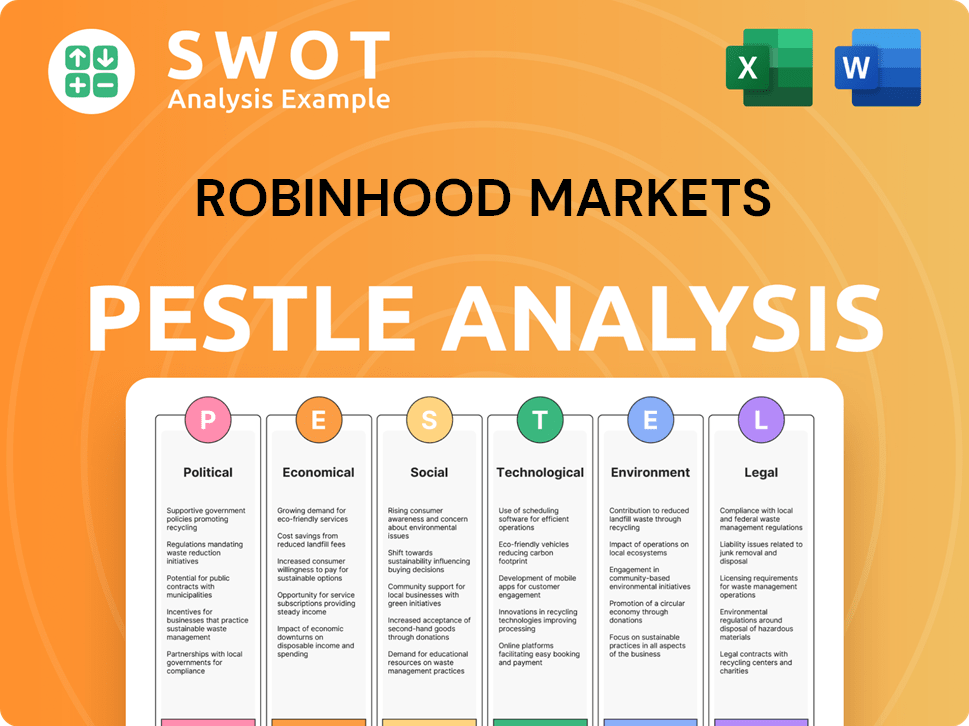
Who Sits on Robinhood Markets’s Board?
The current board of directors at Robinhood Markets plays a vital role in the company's governance. As of early 2025, the board typically includes co-founders Vladimir Tenev (CEO) and Baiju Bhatt (Chief Creative Officer). Their presence, combined with their significant Class B shareholdings, grants them substantial voting power, ensuring their strategic priorities remain central to the company's operations. The board also includes independent directors with backgrounds in finance, technology, and regulatory compliance.
The board's composition reflects a mix of founder representation, major shareholder interests, and independent expertise. Institutional investors often exert influence through engagement with management and proxy voting. The company's dual-class share structure gives Tenev and Bhatt outsized control over shareholder decisions, even if their economic ownership percentage is not the majority. Regulatory scrutiny and public sentiment have indirectly shaped decision-making, increasing emphasis on risk management and compliance.
| Board Member | Title | Notes |
|---|---|---|
| Vladimir Tenev | CEO | Co-founder, significant Class B shareholder |
| Baiju Bhatt | Chief Creative Officer | Co-founder, significant Class B shareholder |
| Independent Directors | Various | Backgrounds in finance, technology, and regulatory compliance |
Robinhood operates with a dual-class share structure. Class A common stock (held by public investors) carries one vote per share, while Class B common stock (primarily held by the founders) carries multiple votes per share, often 10 votes per share. This structure gives Vladimir Tenev and Baiju Bhatt significant control. For more insights into the company's strategic direction, consider reading about the Growth Strategy of Robinhood Markets.
The board of directors at Robinhood Markets includes both founders and independent members.
- Co-founders Tenev and Bhatt hold significant voting power through Class B shares.
- Independent directors bring expertise in finance, technology, and compliance.
- The dual-class share structure gives founders substantial control over shareholder decisions.
- Institutional investors influence the company through engagement and proxy voting.
Robinhood Markets Business Model Canvas
- Complete 9-Block Business Model Canvas
- Effortlessly Communicate Your Business Strategy
- Investor-Ready BMC Format
- 100% Editable and Customizable
- Clear and Structured Layout
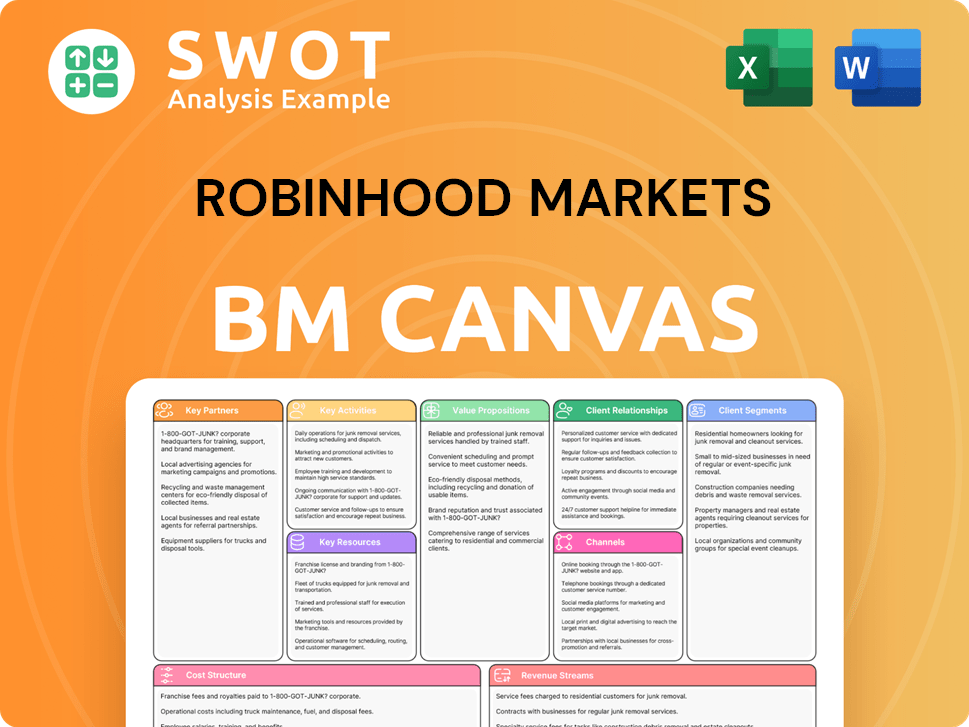
What Recent Changes Have Shaped Robinhood Markets’s Ownership Landscape?
Over the past few years, the ownership landscape of Robinhood Markets has seen significant shifts. Following its initial public offering (IPO) in 2021, the company's stock experienced volatility, impacting both institutional and retail investors. The focus on profitability and expanding beyond trading, including offerings like retirement accounts and crypto wallets, has been a key strategic move. This strategy aims to broaden its customer base, which in turn influences investor confidence and ownership trends. Understanding the dynamics of Robinhood ownership is crucial for anyone following the fintech space.
In 2023 and early 2024, Robinhood has concentrated on enhancing its financial performance and broadening its product offerings. While there haven't been major share buybacks or secondary offerings that have dramatically changed the ownership structure recently, the company's performance and strategic initiatives continue to influence institutional holding patterns. Leadership changes, such as key executive hires, can signal evolving strategic directions that attract or deter certain types of investors. The broader industry trend shows increased institutional ownership in fintech companies, often driven by their inclusion in major indices. Founder dilution is a natural outcome of multiple funding rounds and public listings, but Robinhood’s dual-class share structure helps maintain founder control. Those interested in the Robinhood Markets company profile should track these developments closely.
| Metric | Data | Source |
|---|---|---|
| Market Capitalization (as of May 2024) | Approximately $15 billion | Google Finance |
| Institutional Ownership (as of Q1 2024) | Around 70% | Yahoo Finance |
| Retail Ownership | Approximately 30% | Yahoo Finance |
The evolution of Robinhood's ownership is a dynamic process. The company’s strategic decisions, market performance, and leadership adjustments all play vital roles in shaping the investor landscape. The company's focus on sustainable growth and profitability suggests a mature approach to its public ownership. For a deeper dive into Robinhood's market approach, consider exploring the Marketing Strategy of Robinhood Markets.
Robinhood's IPO in 2021 was followed by stock price volatility. The company is now focused on profitability and expanding its services. These changes influence investor confidence and ownership trends.
Institutional ownership is significant, around 70% as of Q1 2024. Retail investors hold approximately 30% of the shares. These figures highlight the mix of investors.
Expanding services beyond trading is a key strategy. This includes retirement accounts and crypto wallets. These moves aim to attract and retain a broader customer base.
Robinhood's dual-class share structure helps maintain founder control. This structure mitigates the dilution of founder influence. This is a common strategy.
Robinhood Markets Porter's Five Forces Analysis
- Covers All 5 Competitive Forces in Detail
- Structured for Consultants, Students, and Founders
- 100% Editable in Microsoft Word & Excel
- Instant Digital Download – Use Immediately
- Compatible with Mac & PC – Fully Unlocked
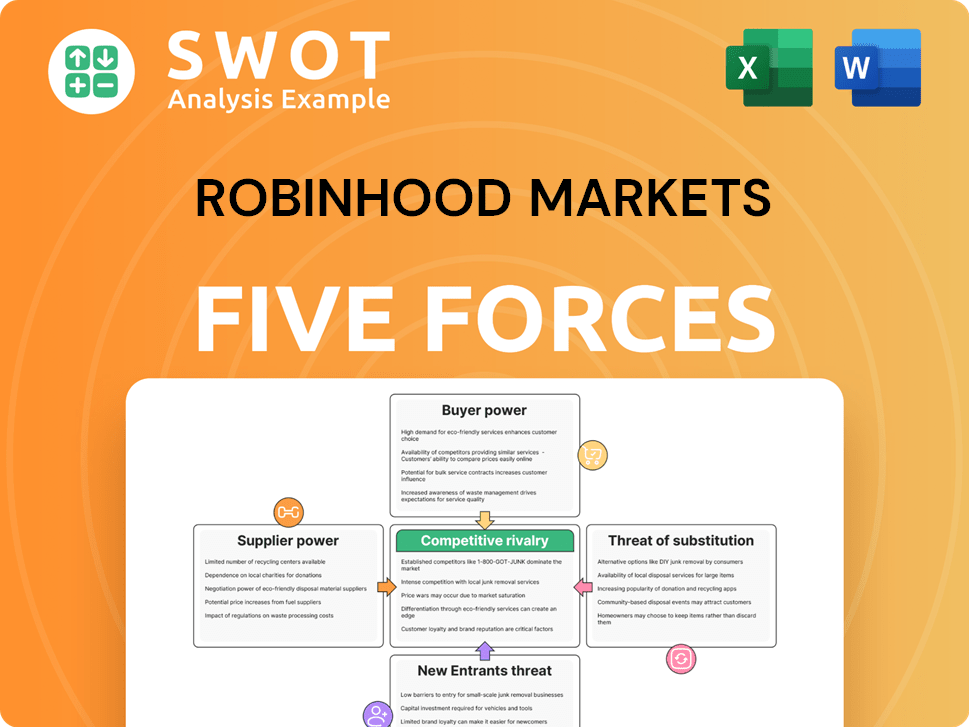
Related Blogs
- What are Mission Vision & Core Values of Robinhood Markets Company?
- What is Competitive Landscape of Robinhood Markets Company?
- What is Growth Strategy and Future Prospects of Robinhood Markets Company?
- How Does Robinhood Markets Company Work?
- What is Sales and Marketing Strategy of Robinhood Markets Company?
- What is Brief History of Robinhood Markets Company?
- What is Customer Demographics and Target Market of Robinhood Markets Company?
Disclaimer
All information, articles, and product details provided on this website are for general informational and educational purposes only. We do not claim any ownership over, nor do we intend to infringe upon, any trademarks, copyrights, logos, brand names, or other intellectual property mentioned or depicted on this site. Such intellectual property remains the property of its respective owners, and any references here are made solely for identification or informational purposes, without implying any affiliation, endorsement, or partnership.
We make no representations or warranties, express or implied, regarding the accuracy, completeness, or suitability of any content or products presented. Nothing on this website should be construed as legal, tax, investment, financial, medical, or other professional advice. In addition, no part of this site—including articles or product references—constitutes a solicitation, recommendation, endorsement, advertisement, or offer to buy or sell any securities, franchises, or other financial instruments, particularly in jurisdictions where such activity would be unlawful.
All content is of a general nature and may not address the specific circumstances of any individual or entity. It is not a substitute for professional advice or services. Any actions you take based on the information provided here are strictly at your own risk. You accept full responsibility for any decisions or outcomes arising from your use of this website and agree to release us from any liability in connection with your use of, or reliance upon, the content or products found herein.